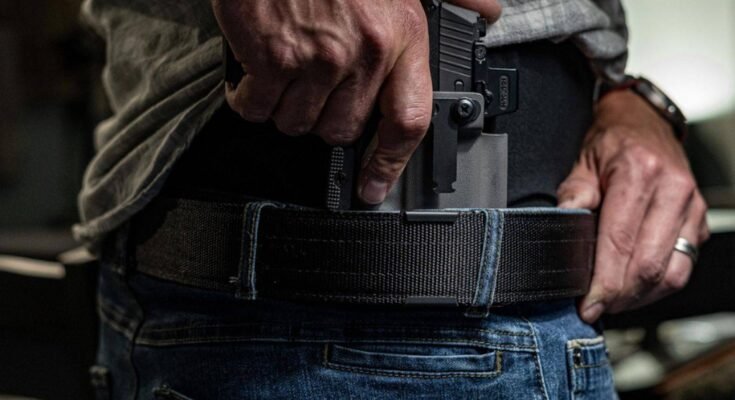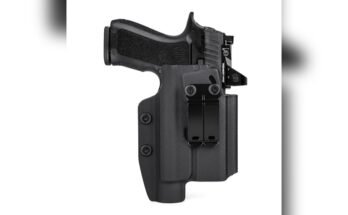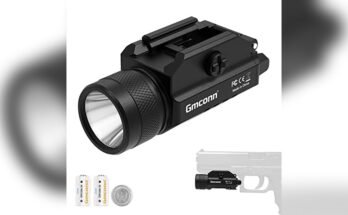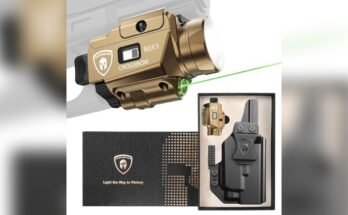If you have ever heard the term AIWB, you have heard a lot of opinions. I have trained with appendix carry for years, both on the range and during daily life. I know what works, what fails, and why comfort and safety matter. In simple terms, an appendix carry holster is a concealed carry holster worn inside the waistband, up front, near the belly button. It keeps the gun close, fast, and hidden. In this guide, I break down how it works, what to look for, and how to carry with skill and care. You will learn the real trade-offs and the simple steps that make appendix carry safe and practical.

Source: inside.safariland.com
What Is An Appendix Carry Holster?
An appendix carry holster is an inside-the-waistband holster set near the front of your body. Think one o’clock for right-handed users, and eleven o’clock for left-handed users. Many people call it AIWB, short for Appendix Inside the Waistband.
This holster is built to keep the gun tight to your body. It helps with concealment under a T-shirt or a light jacket. It also puts the grip in a spot where your hand can grab it fast.
Most AIWB holsters are made of Kydex, a stiff plastic. It holds the gun shape, covers the trigger guard, and allows a safe, clean draw. Good designs add small parts like a claw and a wedge that push the grip in and the muzzle out for better comfort and concealment.
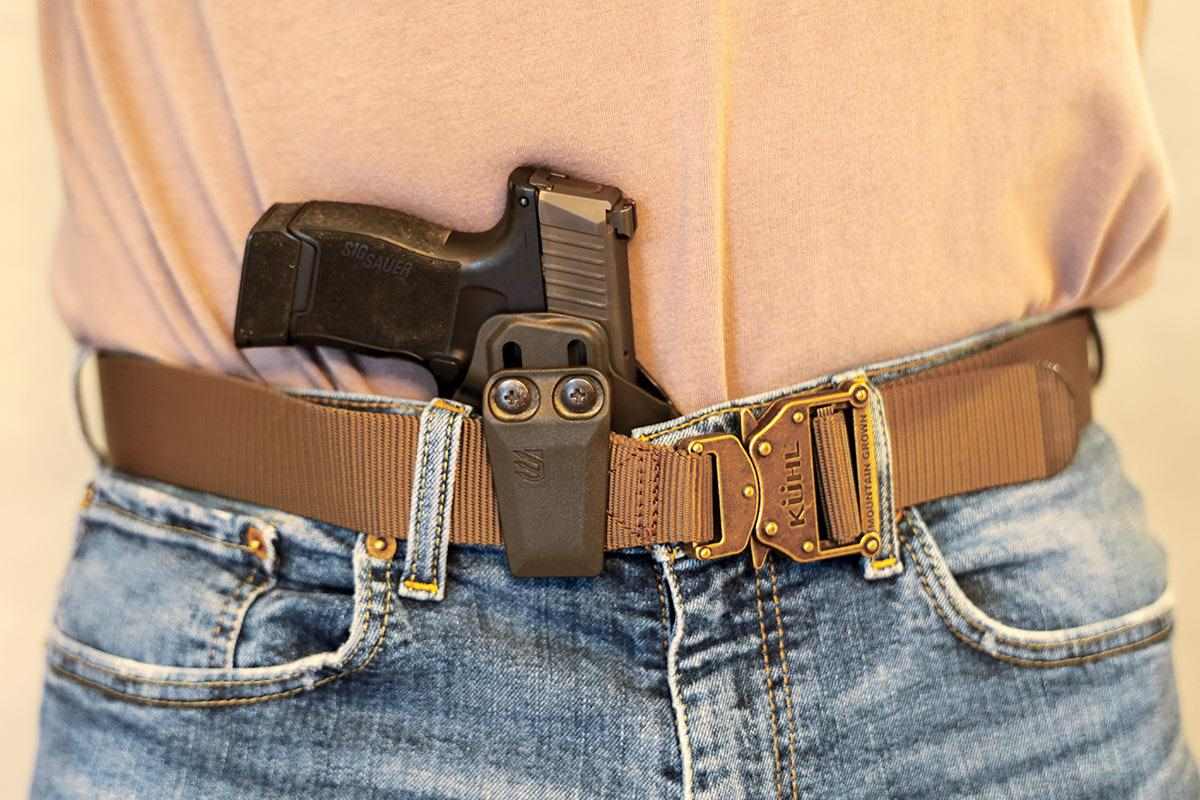
Source: www.handgunsmag.com
Why People Choose Appendix Carry
Appendix carry has real benefits. It offers speed, concealment, and control. It also comes with trade-offs you should know.
Key reasons people use AIWB:
- Faster draw from a natural hand position near your center line
- Better concealment with the grip tucked in
- Strong retention with the gun held by the belt and body
- Good access while seated or driving
Real trade-offs to plan for:
- Comfort can vary, especially when sitting for long hours
- Body shape and clothing matter more than with other carry spots
- Extra attention is needed during holstering for safety
From my time teaching concealed carry, I have seen the draw speed benefit over hip carry in timed drills. I usually see a small but repeatable gain, often a few tenths of a second. That matters under stress, but only if safety is rock solid.

Source: blade-tech.com
Anatomy Of A Quality Appendix Carry Holster
A good AIWB holster is simple but smart. Look for these parts and features.
- Trigger guard coverage: The trigger must be fully covered. No gaps. This is non-negotiable.
- Rigid shell: Kydex or similar rigid material that does not collapse.
- Adjustable retention: A screw to tune how tightly the holster holds the gun.
- Claw or wing: A small lever that pushes against the belt to pull the grip closer to your body.
- Wedge or pad: A soft or angled piece at the muzzle end that tilts the gun for comfort and concealment.
- Belt attachment: Strong clips or soft loops that fit your belt width and keep the holster stable.
- Sweat guard: A smooth edge between the slide and your skin for comfort.
I have tested holsters that skip the wedge. They print more and feel worse when seated. Add a wedge and the difference is night and day.
Fit, Body Type, And Clothing
Appendix carry is personal. Your body shape, belt, and clothes change the result.
- Belt: Choose a stiff belt that does not sag. It spreads the pressure and keeps the gun stable.
- Rise and cut of pants: A slightly higher rise helps. Very tight waistbands make it harder.
- Shirts: Patterns, darker colors, and a light overshirt hide grip edges. A plain thin T-shirt can print more.
- Holster ride height and cant: Small changes can fix hot spots or printing. Adjust and test.
I coach students to make one change at a time. Adjust ride height. Wear it for a day. Then adjust the wedge or claw if needed. Simple tweaks solve most comfort issues.
Safety Fundamentals For AIWB
Appendix carry can be very safe when done right. The rules are simple and strict.
- Keep your finger off the trigger until you are on target and ready to fire.
- Use a rigid holster that fully covers the trigger guard.
- Do not re-holster fast. Re-holster slow, clear the clothing, look the gun in if needed.
- Stand up straight when holstering. Do not hunch or roll your hips toward the muzzle.
- Keep shirts, drawstrings, and cords clear of the holster mouth.
- If you feel resistance while re-holstering, stop. Remove the holster if needed, fix the issue, and re-seat.
On the range, I have seen more near-misses from rushed re-holstering than from the draw. The fix is easy. Slow is safe. Safe is fast in the long run.
Drawing And Re-Holstering: A Practical Walkthrough
You can draw cleanly with simple steps. Always train with an unloaded gun first.
- Set your stance. Build a stable base with your hips square to the target.
- Clear the cover garment with your support hand high and tight.
- Get a full firing grip while the gun is still in the holster.
- Draw straight up, rotate the muzzle out, then drive to your sight picture.
- Re-holster only when you have decided to stop shooting and the scene is safe.
- Sweep the garment clear. Look the holster mouth if needed. Go slow and deliberate.
Dry practice builds habits. I start students with five minutes a day. Ten clean reps beat fifty rushed reps.
AIWB Vs Hip Carry Vs Behind-The-Hip
Each carry spot has strengths. Choose the one that fits your life.
- Appendix carry: Fast access, great concealment, strong control when grappling. Needs careful re-holstering.
- Hip carry, strong side: Comfortable standing. Slower when seated. Easier re-holster angle.
- Behind-the-hip: Good comfort for some body types. Can print when you bend. Slower access while driving.
My own use leans to AIWB for daily wear and long days at a desk. For heavy lifting work, I sometimes swap to strong-side hip to keep the front clear.
Legal And Policy Considerations
Know your local laws. Some places limit where and how you can carry. Private property and workplaces may set their own rules.
- Check permit rules and reciprocity if you travel.
- Learn the standards for safe storage in your area.
- Understand use-of-force laws and when deadly force is allowed.
- Follow range policies about drawing from concealment.
Consult current state statutes and official guidance. Laws change. When in doubt, seek qualified legal advice.
How To Choose The Right Appendix Carry Holster
Pick gear that matches your gun, body, and use case. Try before you buy when you can.
- Model-specific fit: Choose a holster molded for your exact gun and light, if any.
- Adjustable retention: Ensure it clicks in and stays put, but still draws clean.
- Claw and wedge: Look for both. They solve most concealment and comfort issues.
- Clip quality: Metal or heavy-duty polymer. It must lock to your belt with zero wobble.
- Finish and edges: Smooth edges reduce hot spots.
- Return policy: A test-and-return window helps you find the right fit.
I keep a small box of wedges and pads of different sizes. One small wedge can change a no-go holster into a daily carry winner.
Comfort, Health, And Daily Carry Tips
Your core and posture matter for AIWB. Small habits make big gains.
- Wear the holster slightly off-center if needed for comfort.
- Use a breathable undershirt to prevent hot spots.
- Take seated breaks to adjust position on long drives.
- If you have a sensitive abdomen or hernia risk, talk with your doctor. Consider a smaller gun or different position.
I once swapped to a shorter slide length for a month after a minor strain. The change kept me consistent without pain. Consistency matters more than the perfect spec sheet.
Maintenance And Daily Checks
Simple care keeps your setup safe and reliable.
- Inspect screws weekly. Add thread locker if they loosen.
- Check clips for cracks or wear.
- Clean lint from the holster and around the trigger guard.
- Replace wedges or pads when they compress or peel.
- Verify your belt is still stiff and supportive.
These five minutes a week prevent most failures I see on the range.
Training Drills And Progression
Build skill in small steps. Keep it safe and track progress.
- Start with dry practice. Ten careful draws per day.
- Add a timer once your form is smooth.
- Practice seated draws with an unloaded gun before live fire.
- Run live-fire strings from concealment only at ranges that allow it.
- Log your best clean draw-to-first-shot time and your average.
I aim for clean, repeatable draws over raw speed. Most people improve fastest when they film short sets and review hand and garment movement.
Common Mistakes To Avoid
These errors show up a lot. They are easy to fix.
- Rushing the re-holster and sweeping in clothing
- Using a soft holster that collapses
- Skipping the claw or wedge and blaming your body type
- Wearing a flimsy belt that lets the holster tilt
- Ignoring legal training and policy updates
Fix the root cause, not the symptom. Good gear and calm habits solve most problems.
Frequently Asked Questions Of What Is An Appendix Carry Holster?
Is Appendix Carry Safe?
Yes, when done with a rigid holster that covers the trigger and with slow, careful re-holstering. Follow basic gun safety rules. Do not rush the re-holster.
What Is The Best Position For AIWB?
Most right-handed users prefer around one o’clock. Left-handed users often use eleven o’clock. Move slightly left or right to avoid pressure points.
Can I Appendix Carry With A Larger Pistol?
Yes, with the right wedge, claw, and belt. Many people carry compact and full-size guns AIWB. Shorter barrels may feel better when seated.
Do I Need A Special Belt?
A stiff carry belt makes a big difference. It keeps the holster stable, improves concealment, and spreads pressure for comfort.
What Clothing Works Best For AIWB?
Use shirts with a bit of structure or patterns. A light overshirt hides grip edges. Pants with a slightly higher rise help with comfort.
Can I Train AIWB At Any Range?
Some ranges allow drawing from concealment, others do not. Check range rules. Start with dry practice at home and seek qualified instruction.
Final Thoughts And Next Steps
Appendix carry is a strong option for concealed carry. It can be fast, secure, and easy to hide. The key is smart gear, a calm draw, and a slow re-holster. Small setup changes solve most comfort issues. Consistent training builds safe habits that last.
If AIWB fits your life, test a solid holster with a claw and wedge, use a good belt, and practice safe reps. Keep learning, measure your progress, and make smart choices.
Want more guides like this? Subscribe, share your questions in the comments, and keep building skill with purpose.
Watch This Video on What is an appendix carry holster?
